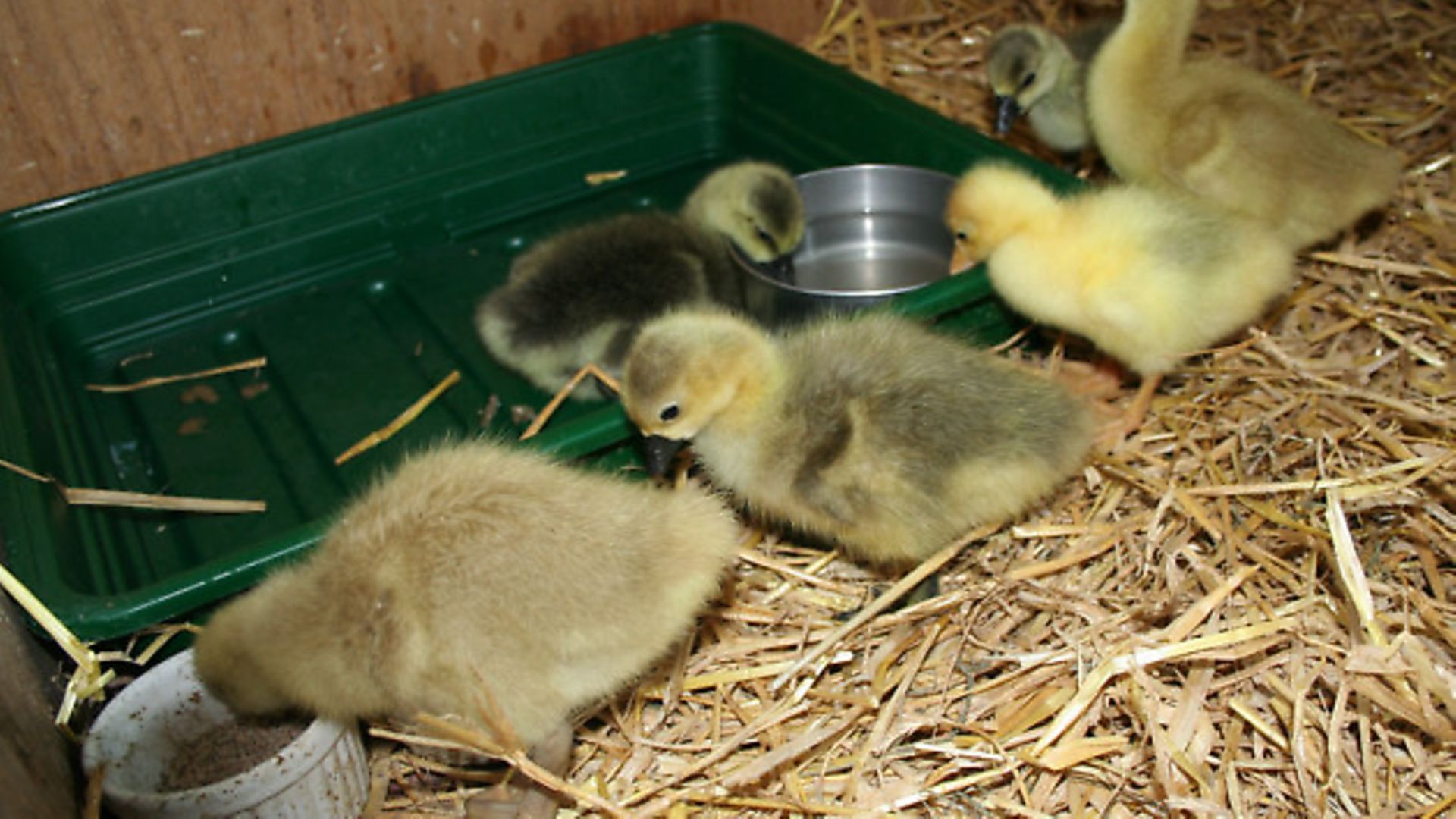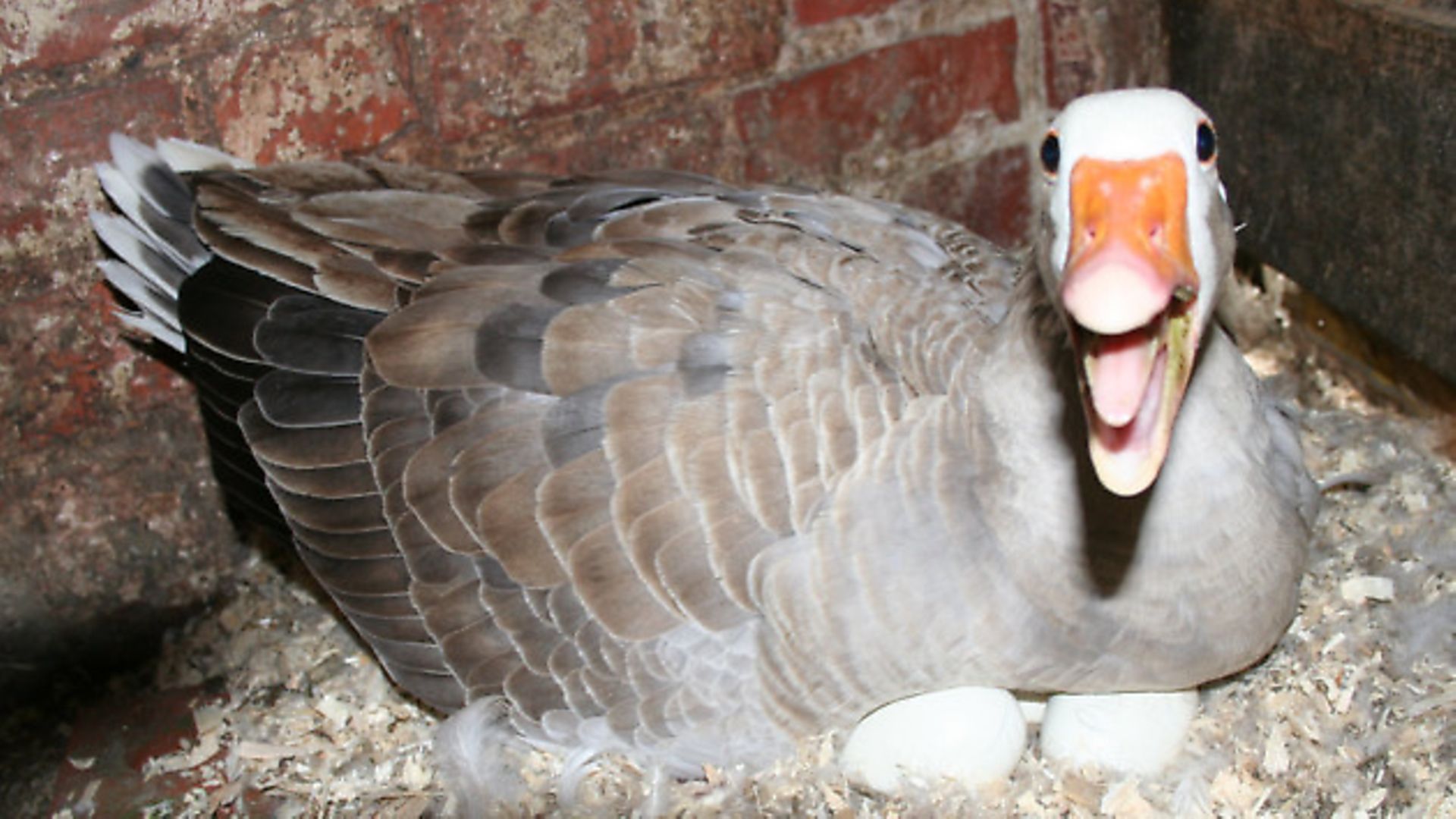Goslings in spring are magical. Just make sure you do your homework…

Springtime is gosling time. Tame geese are companions all year, but goslings in spring are magical. Don’t imagine you can rear a few tame goslings for the table and then kill them for Christmas. Your conscience won’t let you. Decide what you want the birds for first – table, pet or pure breed – and treat them well and appropriately. As with all livestock, have a definite plan for outcome as well as procedure, which includes plenty of time to observe.

The broody goose
The tamest goslings are the ones imprinted on their owner rather than a mother goose. However, the goose can do a far better job of incubation than your incubator. If you have chosen natural hatching, a tame goose (and gander) is far easier to manage than one who fiercely protects her eggs.
It is essential to take good care of a broody goose. After a 30-34 day sit, she will lose more than a third of her bodyweight, far more than a hen. A yearling also needs more observation than an experienced goose. The broody must be coaxed off the nest at least once a day to eat, drink and wash. With a tame bird, this can be done twice daily. Check that she eats and defecates, away from the nest. First remove the gander from the area if he is a problem.
Many females are lost in spring through lack of care. So, always worm a goose that has just gone broody with a propriety single-dose drench. Worm the gander too: both adults are then clear of parasites and will not infect goslings. Also check both for external parasites; infested broodies cannot sit. Choose clean nesting material which is deep enough to avoid the smashing of eggs on a lower hard surface. The location should preclude predation by crows and rats.
Record the date of sitting and, during the incubation period, check the development of the eggs. Some may not be fertile; some fail during incubation; some may get broken and none may hatch. Find out how to candle the eggs to check for fertility, development and water loss. Any infertile eggs can stay in the nest; they won’t change a great deal. Eggs which have started and failed will go rotten and explode, so they must be removed.
Candle eggs around day 10, when the goose is off the nest, and also during their course of development. If none is fertile, there is no point in the goose continuing to sit. It’s difficult to break a goose from a long period of broodiness, and to reinvigorate her appetite, if she has no goslings to stimulate her.
Hatching
We use a combination of nests and incubators for development, but finally hatch most eggs in the incubator (hatcher). Eggs are monitored during development, and transferred from the nest to the hatcher when the size of the air sac is correct.
Pipping on days 28-32 perforates the egg, and can lead to nest-eggs being squashed. Goslings too can be trampled and killed, even as they emerge, by large goose feet. The heavy domesticated goose is not the ideal broody compared with the light-weight Greylag. Thus a small easy-to-clean hatcher is very useful at this later stage. The goslings can be put back with the goose after 48 hours, if she is accustomed to a couple already. The hatcher and candler are also useful for checking on signs of life in dubious eggs.
The first few days
Although there is no better sight than a goose with young goslings, they will be lost to predators and adverse weather if not well protected. Goslings from the hatcher are often reared on their own because it is easier and safer. There are fewer losses when reared indoors and in a secure garden until around 4-5 weeks.
Old, clean cloth (discarded after a few days) is the best surface for hatchlings. Crumpled cloth, with a good grip, prevents spraddled legs. During those first few days, the birds find that crumbs are the right food. So, on transferring to chopped straw/white wood shavings, they soon realise that bedding should not be eaten. Do not use expandable/absorbent horse-bedding products which can kill. The rearing system should be designed to provide water yet be hygienic i.e. to protect from moulds and the threat of aspergillosis which can develop in wet bedding. Do not use hay.
A reliable heat source is also essential. Dull emitters (ceramic bulbs) are better than glass lamps, accustoming the birds to natural light cycles. Over-heating will kill, so monitor behaviour. Newly-hatched goslings will pant from over-heating, unaware of retreating to a cooler space. The temperature under the heat source should be 36 degrees falling to 32 during the first week, with no draughts. Once moving around, the distribution of the birds will indicate if they are happy. A tight group under the heat source is cold; the weakest in a group of nine or more can get suffocated. Dispersal away from the source means it’s too hot. Raise the lamp in stages as the birds grow to ‘harden them off’.
Newly hatched waterfowl do not need feeding straight away. The yolk sac, drawn into the body during hatching, supplies food and water for the next 24-48 hours. However, goslings should be familiarised with a small, safe water container. Unlike chicks, waterfowl don’t need an ante-coccidial in the feed, but do need more vitamin B. It can be difficult to locate specialist food, so make early enquiries. Goslings must also have greens, both as a nutritional requirement, and to satisfy their natural instinct to graze. So, collect tender goose grass, dandelions and cauliflower trimmings (not lettuce and cabbage) to supplement their diet.
Getting outdoors
Goslings need sunlight, exercise and grass to develop strong legs. They suffer from vitamin deficiency if confined. They should move on to grower pellets by three weeks to reduce the protein from 18 to 15 percent. Feeding grower pellets ad lib, with clean grazing and gritty sand, is best. Reduce pellets if they are growing too fast, and during the period that they grow their flights (4-7 weeks).
Although goslings are voracious grazers, and need grass to be healthy, they should be well-fed on pellets (plus wheat). This prevents them from picking up a large parasite load of gizzard worm and coccidia. Clean grazing, not contaminated by dropping of older birds, is essential. Commercial establishments use an all-in/all-out policy to rest the ground between seasons and break the parasite cycle. If adults accompany the goslings, they must be parasite-free.
Raising goslings can be simple, but all too often there is a disaster through lack of observation. Be prepared to monitor the broody carefully, and to watch the goslings for their first five weeks. After that, geese are the best lawnmowers for the summer, and are fairly self-sufficient.
Image(s) provided by:
Archant







